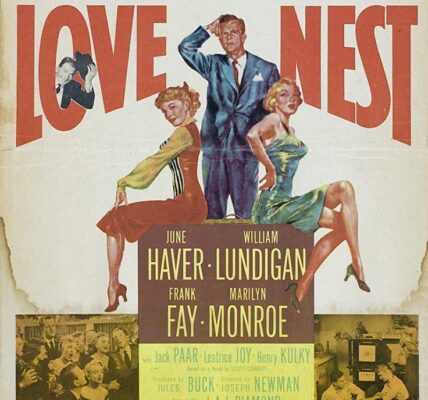**”Let’s Make It Legal”** (1951) is a romantic comedy film notable for featuring Marilyn Monroe in a supporting role as she was on the brink of superstardom. The film focuses on a humorous and lighthearted look at marriage, divorce, and romantic entanglements.

### Film Details:
– **Title**: Let’s Make It Legal
– **Release Year**: 1951
– **Genre**: Romantic Comedy
– **Director**: Richard Sale
– **Screenwriters**: I.A.L. Diamond, F. Hugh Herbert
– **Cinematography**: Lucien Ballard
– **Production Company**: 20th Century Fox
– **Runtime**: 77 minutes
– **Main Cast**:
– **Claudette Colbert** as Miriam Halsworth
– **Macdonald Carey** as Hugh Halsworth
– **Zachary Scott** as Victor Macfarland
– **Barbara Bates** as Barbara Denham
– **Marilyn Monroe** as Joyce Mannering (supporting role)
– **Robert Wagner** as Jerry Denham

### Plot Summary:
The story centers around **Miriam Halsworth** (Claudette Colbert) and her ex-husband **Hugh Halsworth** (Macdonald Carey). After many years of marriage, Miriam has recently divorced Hugh, but he is not entirely out of the picture. While Hugh wants to rekindle their relationship, Miriam finds herself courted by an old flame, **Victor Macfarland** (Zachary Scott), who is a wealthy businessman.
Miriam’s daughter **Barbara** (Barbara Bates) and her husband **Jerry** (Robert Wagner) are also caught up in the family drama, and they navigate their own romantic issues as they watch Miriam struggle between her old and new relationships. The movie is filled with humorous situations and misunderstandings as the characters sort through their romantic entanglements.

### Marilyn Monroe’s Role:
Marilyn Monroe plays **Joyce Mannering**, the young and glamorous girlfriend of Victor Macfarland. Though Monroe’s screen time is relatively short, her role as the seductive and confident Joyce catches the eye of the audience. Joyce represents the “other woman,” adding some comedic tension between Miriam and Victor. Monroe’s portrayal of Joyce is marked by her signature charm, beauty, and playful flirtation, which would soon become hallmarks of her roles in the 1950s.
While Monroe is not the central character in this film, her growing appeal and star power are evident, and her performance was one of the highlights for many viewers, showcasing her as an emerging Hollywood sensation.

Themes:
– **Marriage and Divorce**: The film explores the ups and downs of marriage, with Miriam and Hugh’s rocky relationship serving as the focal point. The movie humorously addresses the complications of post-divorce life and the possibility of rekindling love after separation.
– **Love Triangles**: With both Victor and Hugh vying for Miriam’s affections, the film presents a classic romantic comedy setup of competition between two suitors, adding to the film’s tension and humor.
– **Generational Differences**: The film also contrasts the romantic ideals of older and younger generations, as seen in the relationship between Barbara and Jerry, versus Miriam and Hugh’s seasoned but fractured marriage.

### Reception:
“Let’s Make It Legal” received moderate reviews upon its release. It was not one of the most critically acclaimed films of its time, but it was appreciated for its lighthearted tone and the performances of Claudette Colbert and Zachary Scott. While the film is often remembered as a typical 1950s romantic comedy, it holds special interest for fans of Marilyn Monroe, as it helped to further establish her as a rising star.
.jpg)
### Marilyn Monroe’s Impact:
Although Monroe was still in a supporting role, her appearance in **”Let’s Make It Legal”** continued to build her image as a glamorous, alluring figure. Monroe’s presence in the film stood out, and within a year of this film’s release, she would become one of the biggest stars in Hollywood, with films like **”Gentlemen Prefer Blondes”** (1953) and **”How to Marry a Millionaire”** (1953).

### Fun Fact:
This film was one of Monroe’s last supporting roles before she became a full-fledged leading lady in Hollywood. Although her character was not central to the plot, her increasing popularity meant that she was given prominent billing alongside the more established stars, signaling her growing prominence in the film industry.
Watch movie:




